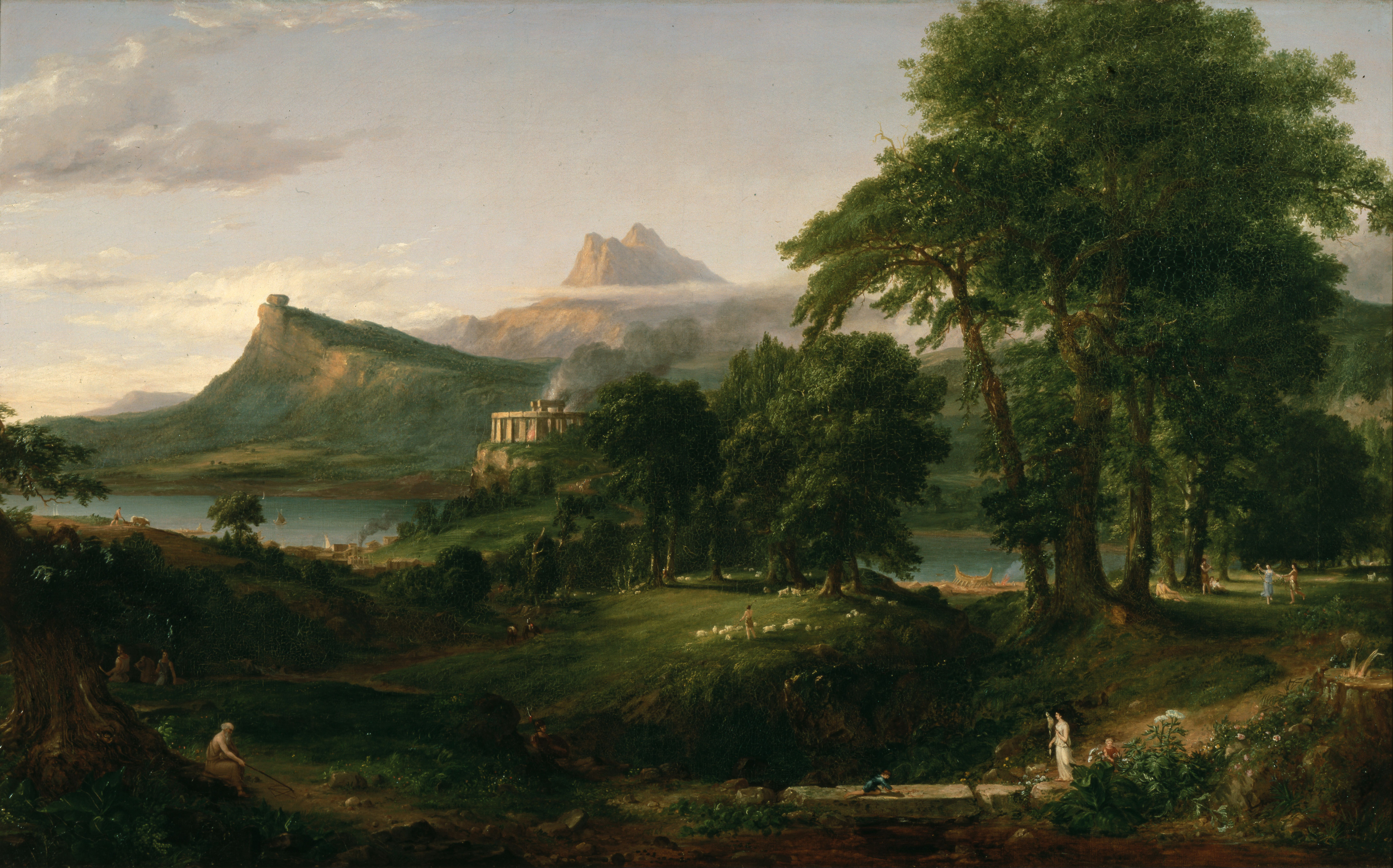In my last post I introduced Gascar's lengthy short story "The Season of the Dead" and I noted how Gascar uses a range of rhetorical devices to mediate the historical events of the Holocaust--the mass genocide gripping a nation and the personal and generational trauma tormenting survivors and their families--and through his text opening up a space for the Holocaust dead to be memorialized. It is a beautiful text, really. I mentioned how he creates a dreamscape mode throughout the story, so that the characters seem only half-conscious, a reasonable response to dealing with the immensity of their trauma. Not only are these characters operating in an illusive dream space, their graveyard recalls the Pastoral. Against this Pastoral, Gascar juxtaposes scenes of murdered babies and dead children--scenes that arouse the sublime.
Gascar’s rhetorical
devices include his diction which one would associate with a nature scene from
the Pastoral. For example, Peter and Cordonat “linger . . . gazing at [their]
surroundings” (121) as though they exist in a time of leisure and beauty. Peter
imagines himself as a mythical being found in a painting of the idyllic: “A man
sitting beside a clump of anemones, another cutting grass with a scythe; water,
and somebody lying flat on his belly drinking, and somebody else with his eyes
turned skyward, drawing water in a yellow jug . . . the water was for me and
Cordonat” (121). Gascar is revealing Peter’s psychological detachment from the
reality of his situation, which emphasizes the dreamscape mode of the text. It
also suggests the hallucinating effect dehydration and malnutrition might have
on the victims in the concentration camp, causing the delirium that makes him
believe he is being offered a jug of water. The text, which is not interested
in mimesis, conveys a compelling psychological rendering of the concentration
camp experience.
 |
| Cole Thomas The Course of Empire |
It
is absurd that Peter can imagine his situation as idyllic; yet the artistry of
the graveyard is equally bizarre, considering the context of the concentration
camp. Gascar foregrounds the artistic quality of the graveyard, emphasizing the
purity of its aesthetic makeup. That is to say that it has been fashioned
entirely from the natural world and not from human structures and monuments. This
distinction is highly important to Peter (and to Gascar). When the Germans have
culled the tombstones from the Jewish grave, Peter is adamant that they will
not occupy his graveyard. He describes the aesthetic quality of the graveyard:
“With its ever green turf, its flowerbeds, its carefully sanded paths edged
with small black fir-trees which we had transplanted, with its rustic fence of
birch-boughs, against the dark background of the forest verge, our graveyard
seemed an ‘idyllic’ place as the Germans put it” (149).
 |
| Beautiful greenspace, perhaps what Peter sees |
He says that they came
out to photograph it and that its fame was “like that which carries crowds to
gaze at certain baroque works of art or at others which, devoid of art, are yet
prodigies of patience and time” (149). While
Peter is wary of the ethical implications of setting up the Jewish stones, he
is most insistent on maintaining the purity of the graveyard’s construction. It
possesses a sacred quality like the Hebrews brought to the construction of the Ark
of the Covenant on which no tool was to be used. Gascar is gesturing to the reader to consider
the integrity of his own aesthetic representation of the Holocaust, whose
construction offers a beautiful memorial in honour of the dead, a beauty which
is always tempered by the horrors contained within its prose.
Gascar recognizes
the literary constraints of representing the Holocaust, which causes him to
assess narrative strategies and discursive practices. Peter considers the
magnitude of suffering experienced by Lebovitch and the Jews:
They took you into
a universe which perhaps had always existed behind the solid rampart of the
dead, and of which the metaphors of traditional rhetoric only gave you
superficial glimpses; where the bread was literally snatched form one’s mouth,
where one could not keep body and soul together, where one really was bled
white and died like a dog (138).
Metaphor breaks down when it tries
to represent the Holocaust. Language which was once full of hyperbole has
become a reality for the Jews. Peter
demonstrates how words, mere signifiers, are loaded with such power because of
Nazi rhetoric that they actually swallow them up in their meaning. Peter
explains: “Like novice sorcerers inexpert in the magic of words, we now beheld
the essential realities of hell, escaping from the dry husks of their formulae,
come crowding toward us and over us: the black death of the plague, the bread
of affliction, the pride of a louse” (138). Gascar illuminates how words are
subject to cultural meaning; these quaint idioms he quotes contain hellish
reality. Certainly, Gascar’s attention to discursive practices is an indictment
against Nazi propaganda which uses words to deceive and control, but it also
reveals his own reticence at narrating this piece of Holocaust fiction.
In the midst of
Peter’s idyllic graveyard, Gascar infuses elements of the sublime as a way to foreground
the singularity of death against the backdrop of mass killings. By employing
the sublime he retains the veracity of representation. Peter is always aware of
the overwhelming horrors unfolding in the camp and at the train docks; yet he
mostly pushes these aside and occupies himself with weeding and transplanting. However
he can’t always avoid horrific confrontations. When he comes upon the mass
grave, these hastily buried corpses pit the extraordinary truth of death
against his abstractions of death. Here he confronts the abject:
I was overwhelmed
by the sombre horror of it and the truth it revealed—these liquefying muscles,
this half-eaten eye, those teeth like a dead sheep’s; death, no longer decked
with grasses, no longer ensconced in the coolness of a vault, no longer sepulchred
in stone, but sprawling in a bog full of bones, wrapped in a drowned man’s
clothes, with its hair caught in the earth (142).
He can’t dress up death here. Gascar
provides another subliminal departure from the dreamscape of Peter’s
sensibility when he focuses in on the train dock: the German guards toss dead
children on to the roofs of the vans. This train scene breaks up the dreamscape
again and Peter zeroes in on the singular experience of a woman. He recounts:
High up in the
wall of the van, a little to the left in the narrow opening, there was a face;
it seemed not living, but painted—painted white, with yellow hair, with a mouth
that moved feebly and eyes that did not move at all: the face of a woman whose
dead child was lying above her head (145).
This face, this countenance, makes
an impression on Peter and he confesses: “Death can never appease this pain;
this stream of black grief will flow forever” (145). Peter realizes that the
burials, the funerals, all his efforts to honour the dead will never remove the
pain, the grief, the memory of a monstrous history. Gascar’s instances of the sublime
force Peter, and the reader, to confront the abominable reality of the
Holocaust. Just when he lulls Peter back into his dreamscape, he erupts the
text with the sublime. Gascar depicts the agonizing experiences of those forced to dig graves, of those forced to bury the dead, of those forced to witness travesty. Through diction and syntax and rhetoric, he creates a dreamscape mode that he, then, disrupts with the sublime. And, it is uncomfortable, but reading about the Holocaust isn't about being comfortable. It's about never forgetting.
In my next post, I'm going to discuss the way that Gascar incorporates fairy tale generic conventions into his story.













